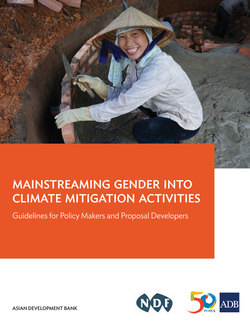Mainstreaming Gender into Climate Mitigation Activities

Реклама. ООО «ЛитРес», ИНН: 7719571260.
Оглавление
Eric Zusman. Mainstreaming Gender into Climate Mitigation Activities
MAINSTREAMING GENDER INTO CLIMATE MITIGATION ACTIVITIES
Contents
Tables, Figures, and Boxes
Acknowledgments
Abbreviations
2.1 The Emergence of Gender in International Climate Negotiations
2.2 The Advent of Nationally Appropriate Mitigation Actions and Intended Nationally Determined Contributions
Step 1: Scoping and prioritizing a mitigation action
Step 2: Political endorsement of the NAMA
Step 3: NAMA design and formulation
Step 4: Political and financial approval of the NAMA
Step 5: Submitting the NAMA to the UNFCCC
Step 6: Approval by international organizations
Step 7: NAMA implementation
Step 8: The MRV framework
Step 9: Reporting to international donors
The Proposal Overview
The Implementing Arrangements
The Financing and Cost Information
Assessing and Tracking Performance
Bibliography
Appendix: Project Proposal Template with Gender Guidance Questions
Отрывок из книги
Guidelines for Policy Makers and Proposal Developers
By Eric Zusman, So-Young Lee, Ana Rojas, and Linda Adams
.....
Boxes
The primary purpose of these guidelines is to fill this need. More concretely, the guidelines aim to equip policy makers, proposal developers, and other interested parties with pragmatic advice on how to mainstream gender into mitigation actions and funding proposals. The guidelines draw heavily on experiences from the Asian Development Bank (ADB) regional technical assistance project entitled Harnessing Climate Change Mitigation Initiatives to Benefit Women. Funded by the Nordic Development Fund, this ADB project aims to assist policy makers in Cambodia, the Lao People’s Democratic Republic, and Viet Nam with integrating gender into national and/or subnational climate strategies, climate action plans, and climate finance screening processes (ADB 2011). The ADB project, like these guidelines, is unique in that it concentrates on the interlinkages between gender and climate mitigation; there has been relatively less attention to the gender–mitigation relationship than that between gender and climate adaptation. Further, while the ADB project focuses on three Southeast Asian countries, this publication is intended for a wide range of countries and stakeholders. The guidelines are, moreover, not meant as a “one size fits all” blueprint; rather, they are intended to serve as flexible “fit for purpose” steps that can be tailored to particular national and local circumstances. They are also intended to outline ways to not only recognize gender co-benefits but also give gender stakeholders an elevated platform and an audible voice at critical junctures of the decision-making process (Huyer et al. 2015).
.....